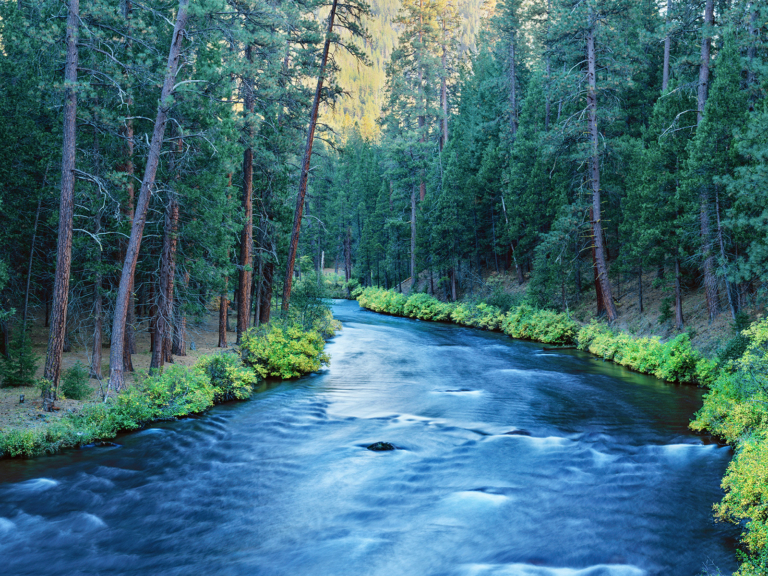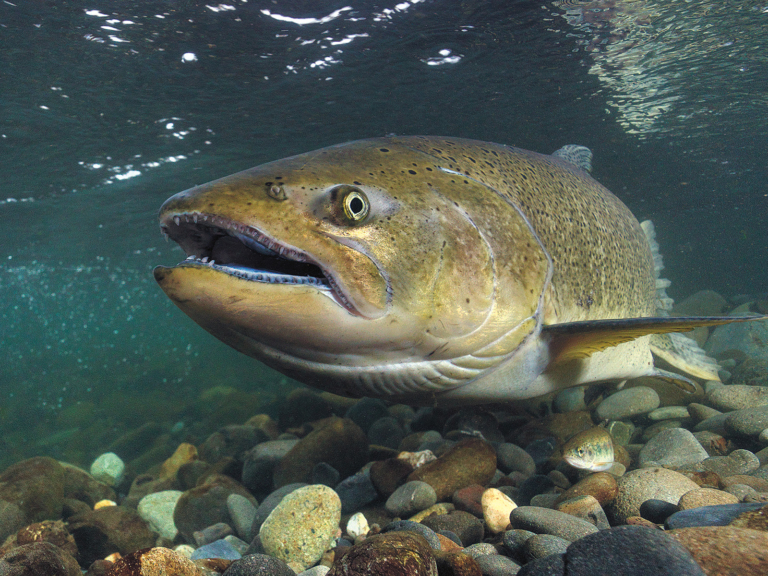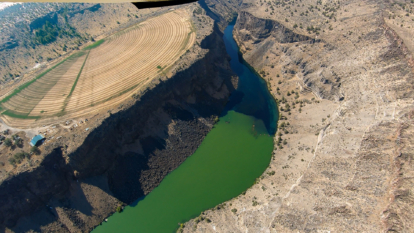The Wrong Green
All dams are dirty. Efforts to make them better only make things worse.
All summer long, Lake Billy Chinook is as green as the Chicago River on Saint Patrick’s Day. Unlike the annual prank bestowed upon the Windy City in celebration of the luck of the Irish, the viridescence of the big reservoir behind Round Butte Dam on central Oregon’s Deschutes River is a murky sign of misfortune, pooling behind a dam the state’s largest utility corporation insists is a source of clean energy.
In 1955, just as America’s dam-building frenzy was reaching a fevered pitch, Oregon attempted to dampen the rush. It took the Federal Power Commission to court over federal permits to dam the Deschutes, contesting the first of what would eventually be three dams that cut off access for salmon and steelhead throughout most of the Deschutes Basin. The state won the first round of the legal battle. Utility interests appealed. The case wound up in the US Supreme Court. The ensuing decision, along with the 1964 construction of Round Butte Dam and abandoned efforts to maintain migrating fish populations, condemned the lion’s share of this desert watershed to a salmon-less purgatory. Portland General Electric (PGE) now sends power from the project over the Cascade Mountains into the populous Willamette Valley.
PGE and the Confederated Tribes of the Warm Springs Reservation co-own these three dams, and the complexities they created. Three rivers feed Lake Billy Chinook. The Crooked and Middle Deschutes are dirty from upstream farms, while the Metolius is as clean and cold as any river comes. Let’s talk about the dirtier pair—the Crooked and the Middle Deschutes—first. A reservoir is a hydrological heat sink. Add fertilizer to this heat and you make an underwater greenhouse. Agricultural runoff, rich in phosphorous and nitrogen, continues the work of its green miracle-making, once entrained in an aquatic environment. Blooms of algae and other photosynthesizing plant invaders, some of them toxic, often ensue. Warm, dammed, polluted water leads to a shamrock-hued toxic stew that spews tons of methane emissions and further drives the climate crisis.
Now let’s talk about the clean river. For 50 years, after the dam’s construction, the saving grace of the last free-flowing 100 miles of the Deschutes River was the Metolius, the purest of those three sister rivers. Due to a magical combination of faulting, volcanism and subsequent prodigious groundwater movement, this river runs with such icy, clear effervescence, your first inclination is to add an olive or a lime rather than a trout fly to it. It pours itself into the larger vessel of the Deschutes, just upstream of the stale, noxious cocktail of Lake Billy Chinook.

Spring-fed and crystal clear, the Metolius River flows 29 miles from its headwaters to Lake Billy Chinook. Designated a National Wild and Scenic River in 1988, this tributary of the Deschutes is home to notoriously tricky-to-catch rainbow trout, along with bull trout, kokanee salmon and mountain whitefish. Photo: Mike Putnam
Here’s the science behind that Metolius grace: cold water condenses and is heavier than warm water. For 50 years, despite the dams, the lower Deschutes River was one of the nation’s premier trout fishing streams. The Metolius’s year-round, 50-degree flow sank to the bottom of the reservoir, whereupon the dam’s outflow valve sent this pure goodness downstream. Anyone who remembers the Deschutes prior to 2010 can recall the result: a river so clear that when you floated at 5 miles an hour over its boulder-strewn bed, you could give in to the sensation you were flying. The fishing was so good, to begin to describe it here would be to give it short shrift.
In 2005, PGE was granted a 50-year license to continue operating its Deschutes dams. To fulfill a long-neglected requirement to provide fish passage, the company went all in for a combination of techno-fix and slick marketing. On its website, PGE claims its hydropower is “emissions free” despite research to the contrary. A growing body of scientific research strongly suggests reservoirs, including PGE’s, invariably emit greenhouse gas in the form of methane. Methane is significantly more destructive than carbon dioxide as it’s 28 times as potent at trapping heat in the atmosphere. According to the EPA, reservoirs with poor water quality in the form of algal blooms tend to produce more methane. And for years, Lake Billy Chinook has spawned harmful algae. PGE and the hydropower industry have pushed a false narrative for decades that dams are an economically viable energy source. They are not.
“I was seeing a river free, that hadn’t been seen that way since my grandfather and great-grandfather saw it. It felt like opening a gate and watching a herd of horses run free.”
For the real fish tale, consider its solution for salmon and steelhead. PGE and the Confederated Tribes of the Warm Springs spent about $110 million on a Rube Goldberg contraption called a Selective Water Withdrawal Tower. Pitched to stakeholders as the thing that would allow PGE to manage the Deschutes “as if the dams weren’t there,” the Tower, for eight months out of the year, mainlines that sickly green water from the surface of the reservoir into the previously pristine lower 100 free-flowing miles of the Deschutes. The results are a menacing reminder that the dams are still very much there.
The shift from clean cold water from the depths of the reservoir to warm, dirty surface water was done in the name of restoring fish passage—which has been a dismal failure. In all 14 years of operation, the Tower project has facilitated passage above these dams of barely 2,000 steelhead, Chinook and sockeye salmon. Divide this number by the cost of the Tower, and these have to be some of the most expensive salmon on Earth.
For all the money and technical expertise spent on the Tower, salmon reintroduction above this dam is still a trap-and-haul program. Fish are siphoned into tanker trucks, driven around the dam and pumped back into the river. Migration aid that includes semitrucks is a travesty. We don’t put sandhill cranes on passenger jets to get them from marsh to tundra and back.

Salmon selfie. Ten years after the completion of the Elwha River dam removal project, steelhead and salmon—such as this adult and juvenile Chinook—are successfully reclaiming their historic spawning grounds. Photo: John McMillan
In 2023, only 19 spring Chinook returned above project. Worse, a recent joint study between Oregon State University and the Oregon Department of Fish and Wildlife suggests the dirty water contaminating the lower river has furnished it with a manifold increase in a parasite known as Ceratonova shasta that’s deadly to spring Chinook. The Tower intended to save salmon is killing them.
As the communications manager for the Deschutes River Alliance, what gives me hope is that every failure of a project like this is a reminder that fish mitigation is not the same as fish and river restoration. Utilities’ raison d’être is not saving fish. Generally, they’ve sucked at it.
“Mitigation” connotes a mindset. It is “the action of reducing the severity, seriousness or painfulness of something.” It implies a docile tolerance for destructive practices that are killing us and the things we love. Where rivers and fish are concerned, we need to recognize—and more importantly, act upon—the knowledge that all dams are dirty. And that “mitigating” for any kind of pollution while doing nothing to eliminate the cause is a kind of insanity. The best hatchery is a healthy river system..
Another thing that gives me hope is the growing inventory of water projects—dam removals being the ne plus ultra of river restoration—that have restored so much more than a riverine ecosystem: the reconstruction of a half mile of Klamath River channel as part of the spine-tingling removal of four dams. The first harvest of salmon out of the Elwha, post dam removal. These projects, and hundreds of others like them, are the result of decades of organizing. They have restored faith in nature to be resilient in the face of even the deadliest threats. They have just as importantly restored an old, familiar, vital sort of faith humans desperately need to have in one another.
For me, one of the themes of the spring season is redemption. Of all the jubilance I’ve witnessed in a quarter-century of writing about all manner of things related to water, I don’t conjure the image of a whitewater rapid or a big fish, but a face.
A geomorphic cousin of the Metolius is the White Salmon River, a few miles from my house. In 2011, Condit Dam was removed, and among the celebratory crowd was Yakama Elder and then-Columbia Inter-Tribal Police Chief Davis Washines. A photographer snapped a picture of him the instant the White Salmon burst forth from the hole that was blown in the base of that dam. The photo depicts Mr. Washines with his head buried in his hand. “I shed a few tears,” recalled Mr. Washines over the phone. “I was seeing a river free, that hadn’t been seen that way since my grandfather and great-grandfather saw it. It felt like opening a gate and watching a herd of horses run free.”
As I’ve watched the White Salmon welcome a steadily increasing number of trees along its banks, insects in the trees and fish in the river, I think of that picture, and of Mr. Washines. When my home waters on the Deschutes are finally free, in the same dam-less wild way that so moved him, doubtless I’ll shed tears of joy and redemption. And I wish that burst of joy for everyone who loves a beleaguered river.


